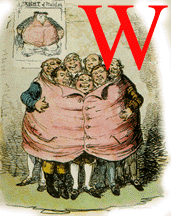 Wonderland's residents and members of Alice's real world speak essentially the same language. However, the creatures in Wonderland take everything literally in a way which causes confusion for both Alice and the reader. What makes sense to Alice does not make sense to them and the other way around. This confusion makes it difficult to differentiate between sense and nonsense, and sanity and insanity. As the Cheshire Cat says, "we're all mad here." (67) Carroll blurs the line between imagination and reality through the constant confusion of language, personhood, and sometimes surprising "real world" knowledge of the creatures inhabiting Wonderland. Alhtough certain elements of Wonderland seem strange to Alice, several of them actually fit into her perceptions and probably appear stranger to the reader than to Alice herself.
Wonderland's residents and members of Alice's real world speak essentially the same language. However, the creatures in Wonderland take everything literally in a way which causes confusion for both Alice and the reader. What makes sense to Alice does not make sense to them and the other way around. This confusion makes it difficult to differentiate between sense and nonsense, and sanity and insanity. As the Cheshire Cat says, "we're all mad here." (67) Carroll blurs the line between imagination and reality through the constant confusion of language, personhood, and sometimes surprising "real world" knowledge of the creatures inhabiting Wonderland. Alhtough certain elements of Wonderland seem strange to Alice, several of them actually fit into her perceptions and probably appear stranger to the reader than to Alice herself.
While falling down the rabbit hole Alice wonders if she will "fall right through the earth" and come out on the other side where people "walk with their heads downwards." (19) Her false notion of geography and gravity and how the world actually works actually proves correct, or at least partially correct. Alice's belief that falling straight through the ground would bring her to a place where people behave very differently than in her world eventually proves true.
Additionally, Alice appears unsurprised by the presence of talking animals. She easily adjusts to the idea of them and accepts their place in Wonderland, and even to some extent in the real world. Upon seeing the white rabbit for the first time, the narrator states, "there is nothing so very remarkable in that, nor did Alice think it so very much out of the way to hear the rabbit say to itself, 'Oh dear! Oh dear! I shall be too late!'" (18) Alice only begins to find the situation strange when she notices the rabbit's waistcoat and pocket watch, and she really only becomes interested in him when he begins to exhibit adult traits. While rabbits do not usually talk in the "real world", their speech probably would not surprise a child who might read fables where anthropomorphized animals were common. However, the idea of an anthropomorphized rabbit checking a pocket watch mixes elements of childhood fantasy with adult reality in a way which piques Alice's curiosity and sends her down the rabbit hole.
Questions
1. How would the book's original title, "Alice's Adventure Underground," affect your interpretation of Wonderland?
2. What role do names like the White Rabbit play within the novel? How do names function differently in Wonderland than in our world? Do they function differently at all?
3. Does the narration help you identify with Alice or does it distance you from her? Do you believe it has the same effect on younger readers?
4. Several works from throughout the semester have shown literature used for escape. How does the treatment of fiction in Alice's Adventures in Wonderland compare or contrast with other works (Jane Eyre, Phantastes, etc.)?
5. We are told that, "Alice was beginning to get very tired of sitting by her sister on the bank, and of having nothing to do: once or twice she had peeped into the book her sister was reading, but it had no pictures or conversations in it, 'and what is the use of a book,' thought Alice, 'without pictures or conversation?'" (15) How do the images created by John Tenniel add to the story? Do they sometimes contrast with the descriptions?
Last modified 11 March 2009